
views
- Feed your land snail juicy fruits like apricots, leafy vegetables like lettuce, sunflower seeds, cooked grains like oatmeal, and rich calcium sources like cuttlebone.
- Feed your freshwater snail aquatic plants like algae, food debris from your aquarium, blanched vegetables, and calcium sources like eggshells.
- Avoid feeding either type of snail processed foods with sugars, citrus fruits, or salts (as the sodium may burn their bodies).
- There’s many different snail species, so check with a vet or pet store worker for diet tips on your specific type of snail.
Feeding Land Snails
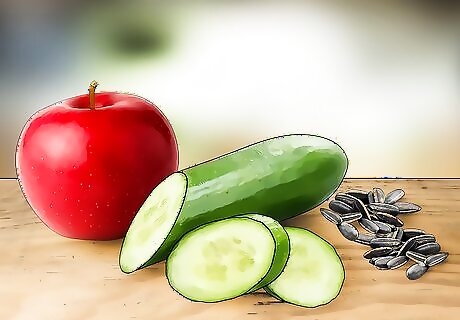
Choose fruit, vegetables, seeds, and grains that are safe for your snail. To feed a land snail, select a wide variety of ripe produce and a few seeds to incorporate into your snail’s diet. Boil hard fruits and veggies before giving them to your snail, but wait for them to cool before feeding (if you have a tortoise, snails also eat tortoise food that’s been soaked in water). Avoid feeding your land snail salty foods, citrus foods, or onion; these repel snails and cause them to lose their appetites. Meanwhile, the following foods are safe for snails: Fruits: apples, apricot, grapes, kiwi, mango, melon, nectarine, raspberry, strawberry Veggies: cucumber, mushroom, lettuce, broccoli, green beans, peas, sprouts, sweet corn, turnip, watercress Seeds: sunflower seeds, pumpkin seeds, and hemp seeds Cooked grains: oats
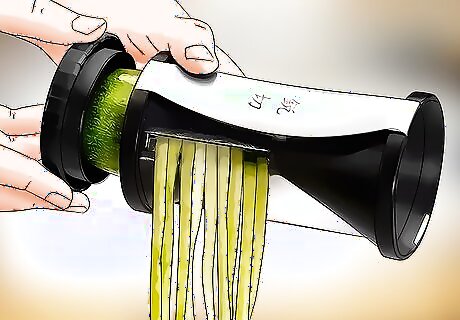
Chop or shred produce into pieces smaller than a dime. Use a vegetable shredder or kitchen knife to chop all produce before you feed it to your snail. Snails are sensitive to chemicals and pesticides, so only use organic produce, and wash it well before feeding it to your snail.
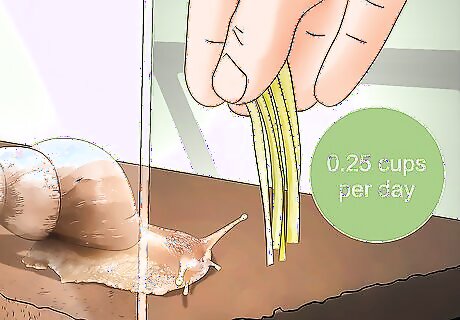
Start by providing ¼ cup (68 grams) of food each day. There is no hard and fast rule about how much food a land snail should eat, so alter your snail’s diet based on how much it eats over time. If your snail is consuming all of the food you're providing, add some to its habitat. Remove any food that isn't consumed within 24 hours to prevent mold or anything that might harm your snail(s).
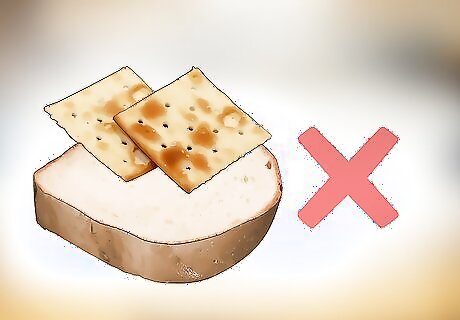
Give your snail organic, whole foods that are easy to digest. Ensure that your snail’s diet is made up of fresh produce and other natural, nutritional carbs. Avoid feeding your snail processed snack foods, or foods that contain sugar or salt. Snails also have trouble digesting rice, millet, pasta, crackers, and bread because they cause bloating. Never feed your snail anything with salt. Sodium burns your snail’s body of its slimy moisture, which can be fatal.
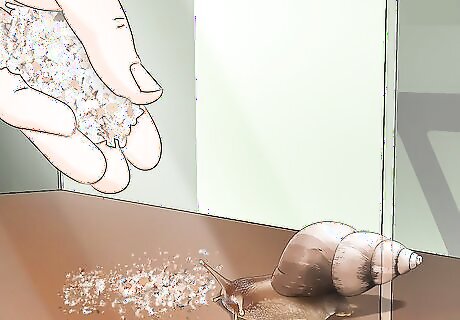
Keep a calcium source in your snail tank at all times. Give your snail lots of calcium so it can keep its shell healthy. Crush or break off pieces of your calcium source and place them in your snail’s tank for it to nibble on. Adjust the portion of your calcium source based on how much your snail eats each time. Great calcium sources for snails include: Cuttlebone Calcium powder Powdered oyster shells Natural chalk Natural limestone Bone meal Wood ash Powdered Egg Shells
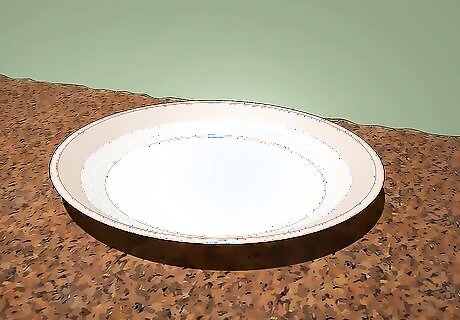
Fill a water dish with spring water and place it in your snail’s tank. You do not need to provide snails with water to drink. However, to ensure your snail’s environment is humid enough, place a shallow dish filled with spring water for your snail to bathe in. Replace the water every 1-2 days. Never use tap water or faucet water, since these water sources may contain chlorine that's harmful to snails. If you don't have access to filtered water, leave tap water out in the sun for 48 hours to remove chemicals.
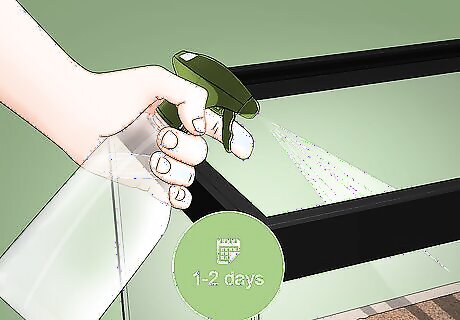
Spray your snail with spring water every 1-2 days. Help your snail stay hydrated by misting it with water. Fill a spray bottle with spring or filtered water, and mist your snail and its habitat about every 48 hours. If you live in a very dry climate, try misting your snail 1-2 times per day.
Feeding Freshwater Snails
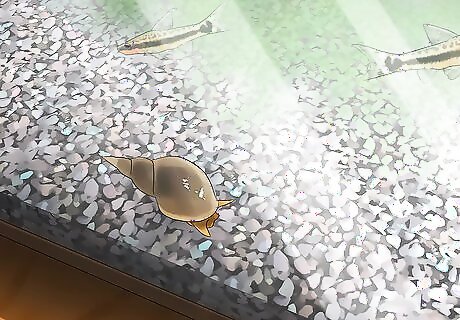
House freshwater snails in an aquarium to fit their aquatic diets. Freshwater snails are omnivores, and they typically subsist off of the algae and food debris in a fish aquarium. Include aquatic plants like hyacinth, duckweed, and water lettuce for your freshwater snail to graze on, too. Check with your vet or a clerk at your local pet store to find out which types of fish live best alongside your species of freshwater snails and vice versa. Nerite snails, rabbit snails, and mystery snails tend to do well in fish tanks while bladder snails, apple snails, and ramshorn snails can be pests in most aquariums. Give your freshwater snails plenty of room to maneuver. Include 1 freshwater snail for about every 2 gallons of water in your tank. Do not, under any circumstance, house your snails with loaches, catfish, betta fish, cichlids, gouramis, and puffer fish. All of these fish are likely to eat your freshwater snails.
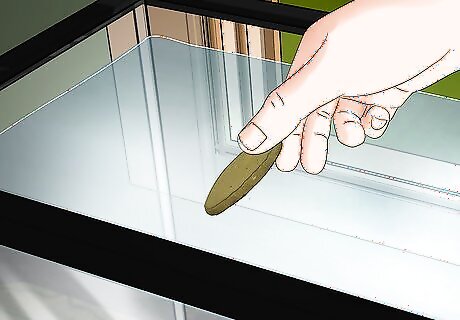
Provide algae disks if your freshwater snails have their own tank. Freshwater snails will eat algae regularly, as long as fish don’t chew it before them. If you don't have fish in the same aquarium as your snails, purchase and feed your snails small algae discs. Follow the instructions on the packaging and provide the right number of disks for the number of snails in your tank. Algae discs are readily available online or at most pet stores.
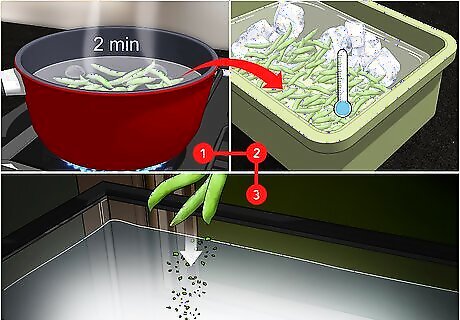
Offer your snails shredded, blanched vegetables. In addition to algae, freshwater snails enjoy a diet of blanched vegetables. To blanch your vegetables, dip your veggies into boiling water for 2 minutes before dunking them in ice water. Freshwater snails especially like to eat shelled peas, carrots, cucumber, zucchini and iceberg lettuce. Allow the blanched vegetables to cool completely. Then, add them to your aquarium. Chop or shred your vegetables into pieces that are smaller than a dime. Begin by adding a small amount of blanched veggies each morning, and gauge how quickly your snails can finish them. Add a bit more or less until you notice that all of the food is being eaten in 12 hours or less. Remove uneaten produce after 24 hours. A good starting place is to feed aquatic snails as much food as they can consume in about 3 minutes, twice daily.
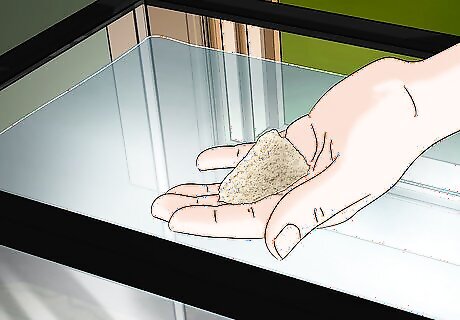
Provide an additional calcium source for your freshwater snails. Just like land snails, freshwater snails require calcium to keep their shells healthy and strong. Provide a calcium source that your snails can nibble on at least once a week, as a supplement to your snails' diet. Some sources of calcium for freshwater snails include: Cuttlebone Shells from dead snails Oyster shells Natural limestone (but be aware that this may raise your tank’s pH levels)
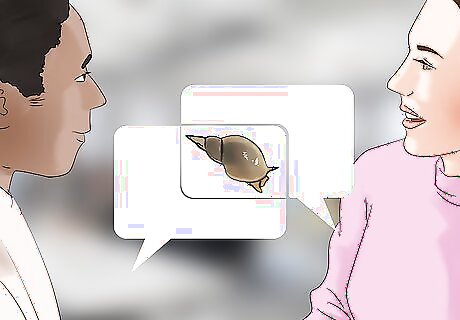
Get advice about your snail's diet from a clerk, expert, or vet. How much, how often, and what you feed your snails will vary based on a number of factors. These factors include: your snails’ species, the number of snails in your tank, and what other aquatic life shares the aquarium with your snails. Speak to someone at the place where you purchased the snails or consult a vet to determine the best way to take care of your freshwater snails. Incorporating a formulated snail food, mashed chicken feed, or other dense macronutrient into your snail’s diet can increase its growth rate and lower its toxicant sensitivity. If your snails are leaving a lot of food behind, try providing a little bit less food or experimenting with different food choices. Some snail species may need additional food sources, such as fish food or bottom feeder tablets.



















Comments
0 comment